
Blackfriars is a restored Grade I listed 13th-century friary in Newcastle upon Tyne, Tyne and Wear, England, located in the city centre, close to the city's Chinatown.

A guildhall, also known as a "guild hall" or "guild house", is a historical building originally used for tax collecting by municipalities or merchants in Great Britain and the Low Countries. These buildings commonly become town halls and in some cases museums while retaining their original names.

The history of Newcastle upon Tyne dates back almost 2,000 years, during which it has been controlled by the Romans, the Angles and the Norsemen amongst others. Originally known by its Roman name Pons Aelius, the name "Newcastle" has been used since the Norman conquest of England. Due to its prime location on the River Tyne, the town developed greatly during the Middle Ages and it was to play a major role in the Industrial Revolution, being granted city status in 1882. Today, the city is a major retail, commercial and cultural centre.
Roger Thornton, the Dick Whittington of Newcastle, seems to have been a country boy who sought his fortune in town. He lived to become 'the richest merchant that ever was dwelling in Newcastell', and three times mayor of that town.

Northampton Guildhall is a municipal building in St Giles' Square in Northampton, England. It is a Grade II* listed building.

William Newton (1730–1798) was an English architect who worked mainly in Newcastle upon Tyne and Northumberland. His work shows a conventional but elegant classical style, influenced by Adam and Paine, and with a strong Palladian feel typical of late 18th century architecture. Most of his buildings are stately homes in rural Northumberland, but he also created some interesting public works in Newcastle: The Assembly Rooms, St Anne's Church, the refaced Guildhall, and elegant private housing in Charlotte Square.

Totnes Guildhall is a 16th-century Tudor historic guildhall, magistrate's court, and prison, in the town of Totnes, south Devon, in southwest England. It is a Grade I listed building.

The Kingston upon Thames Guildhall is a municipal building in Kingston upon Thames in England. It is situated in the High Street, adjacent to the Hogsmill River. The guildhall, which is the headquarters of Kingston upon Thames London Borough Council, is a Grade II listed building.
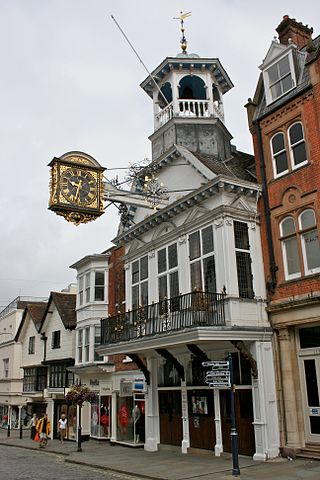
The Guildford Guildhall is a Guildhall located on the High Street of the town of Guildford, Surrey. It is a Grade I listed building.
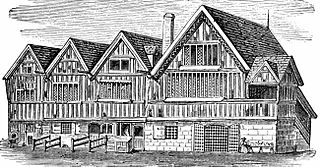
Nottingham Guild Hall was built on Weekday Cross in Nottingham. Originally a hall for the merchant Guilds, it became the Court House and Town Hall of the Nottingham Corporation. The building was demolished in 1895.
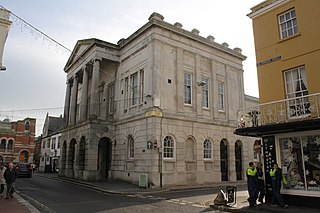
Weymouth Guildhall is a former guildhall at Weymouth, Dorset, England. The building, which was constructed in the 1830s, is a Grade II* listed building.
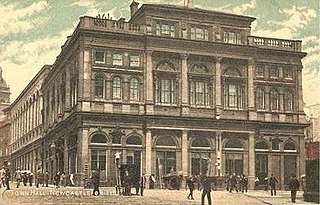
The Town Hall was a local government building located in St Nicholas Square, Newcastle upon Tyne.

Stratford-upon-Avon Guildhall is a historic building in Church Street, Stratford-upon-Avon, Warwickshire, England. It is a Grade I listed building. Dating from the early 15th century, the Guildhall was for centuries at the centre of life in Stratford, being used for assemblies, as a meeting place for the local council, and as a school building for the King Edward VI School. Most famously William Shakespeare almost certainly attended school here. The building was opened to the public in 2016, after being restored.

The Guildhall is a municipal building in High Street, Newcastle-under-Lyme. It is a Grade II listed building.
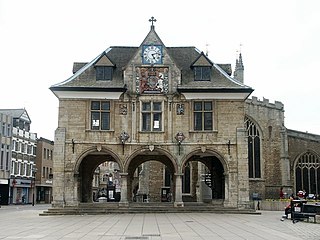
Peterborough Guildhall is a municipal building in Cathedral Square, Peterborough, Cambridgeshire, England. It is a Grade II* listed building.
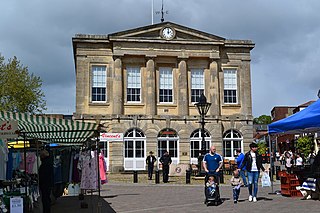
Andover Guildhall is a municipal building in the High Street, Andover, Hampshire, England. The guildhall, which was the headquarters of Andover Borough Council, is a Grade II* listed building.

Bridgwater Town Hall is a municipal building in the High Street, Bridgwater, Somerset, England. The town hall, which was the headquarters of Bridgwater Borough Council, is a Grade II listed building.

Newport Guildhall is a municipal structure in the High Street in Newport, Isle of Wight, England. The guildhall, which was the headquarters of Newport Borough Council, is a Grade II* listed building.

Liskeard Guildhall is a municipal building in Pike Street, Liskeard, Cornwall, England. The structure, which was the meeting place of Liskeard Borough Council, is a Grade II* listed building.

Chipping Norton Town Hall is a municipal building in the Market Place, Chipping Norton, Oxfordshire, England. The building, which is used as an events venue, is a Grade II* listed building.




















